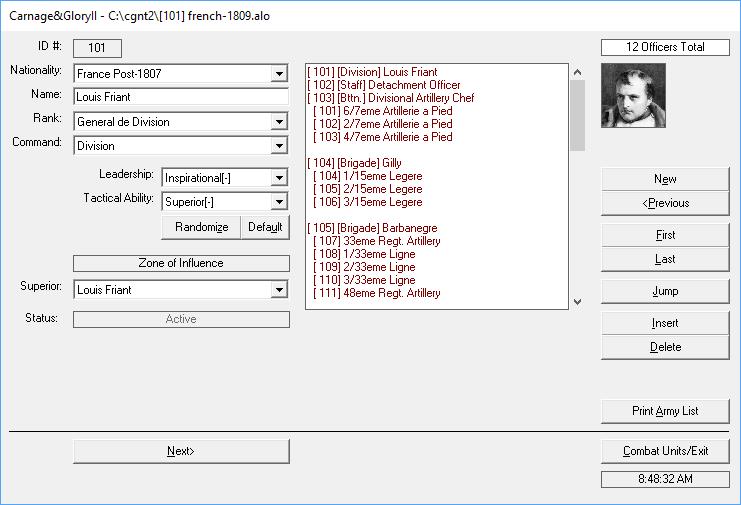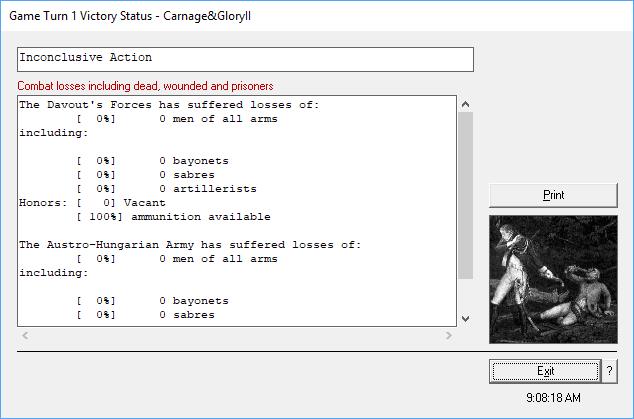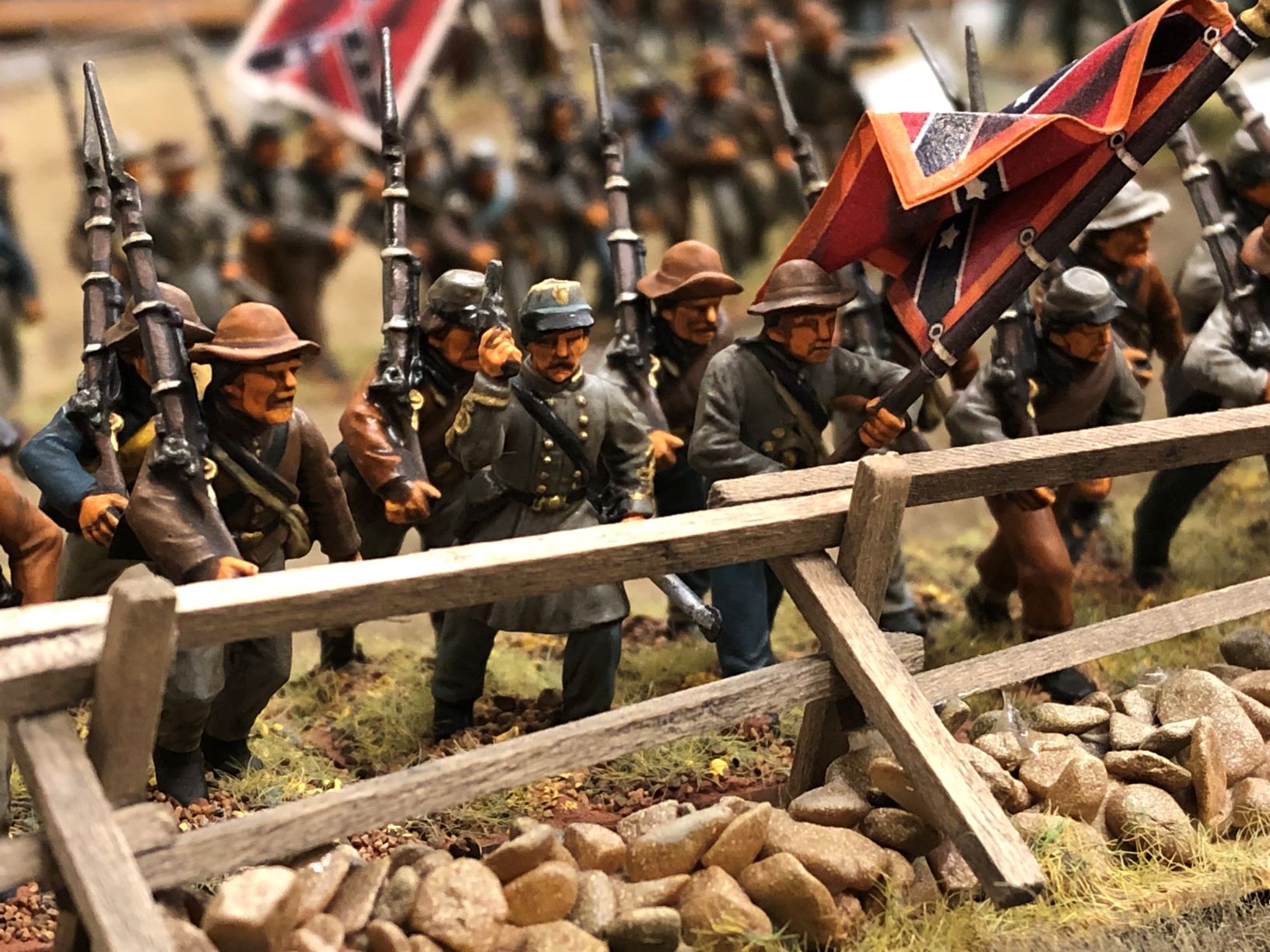|
|
Pike and Shot System Main Screen: Napoleonic System Main Screen: Seven Years War System Main Screen: American Civil War System Main Screen: Marlburian System Main Screen: Franco-Prussian System Main Screen:

Pike and Shot System Main Screen:
The game system
uses the following menu options:
File:
With the following options,
Creating, Opening, Saving, Duplicating and Deleting of Army List and Order
of Battle Files, which are the heart of the database used by the system to
manage and moderate your miniature collections and table-top wargames.
Create Army List General Officer - File: Environmental Options Form - Utilities: Pregame Formations by Officer - Utilities: Command Review Order of Battle - Battle:

Create Army List General Officer - File:
|
|
The Army List
represents of database of General Officers and Combat Units. Various
historical lists have been prepared as companions to the basic system to
reflect the composition of different forces engaged in particular battles or
campaigns. The basic system comes pre-loaded with two army lists. The Order of
Battle represents a database of General Officers and Combat Units selected
from two or more army lists that you wish to engage in a table-top wargame
scenario.
|
|
Pre-Battle
Utilities:
With the following options,
Environmental conditions, Army Initiative, Scouting, Naming of Armies and
Battle, presetting Formations, Fatigue, Ammunition and Reserve and Flank
Forces. Army Initiative
and morale is a barometer of an army's relative combat worthiness in
comparison to its opponent. It is affected by the individual combat units
relative strengths, fatigue and morale condition and active General Officers
leadership and tactical qualities. If one army's morale is sufficiently low
and lower than its opponent, then the result will be the progressive
reduction in individual combat units morale status. However this downward
spiral can be slowed and even reversed by the arrival of friendly off-table
reserves, or improvement in individual units fatigue and morale levels.
|
|
|
|
Battle:
With the following options, Issue Orders, Engineering, Movement, Fire, Close Combat, Rally and End of Turn Phases,
and Command and Control features, including reviewing command structures, by
commands or individual units or officers, Reassignment of individual
officers or combat units, Issuing of combat orders, reviewing Army
Initiative and current Victory Status comparisons.
Each game turn,
which represents fifteen minutes of real battle action, is sub-divided into
the following phases: Each phase is sequential such that engineering should
be performed before movement, which is before fire action and so on.
During this phase available combat units can engage in light field engineering tasks, which might include demolition, light construction and incendiary action. Units that perform engineering tasks may be prohibited from formation changes and fire action, and may typically incur fatigue loss. During this phase combat units can attempt to charge, change formation, double, perform passage of lines or voluntary routs and cross disruptive terrain. All necessary morale checks and fatigue loss is automatically calculated as required by the selected option. During this phase combat units can engage in unit to unit fire combat. All necessary morale checks, fatigue and combat strength losses will be automatically calculated dependent upon the physical circumstances affecting and relating to the firing and target units.
During this phase combat units that are determined to be actual or more realistically near physical contact are engaged in melee. All necessary morale, fatigue and combat strength losses will be automatically calculated dependent upon the physical circumstance affecting each unit engaged in the combat. During this phase combat units as required, due to weakening morale, can be inspected and rallied by general officers in an attempt to improve the units current state of order and morale level. Some general officers, depending on their leadership qualities and position in the army's chain of command will perform this duty better than others. This phase is mandatory at the end of each game turn. The Army Initiative status will be displayed. The army with the better army initiative is given the option of moving before or after their opponent. This alternate move system avoids many of the traditional pitfalls associated with simultaneous movement. General officers will be advised of the receipt of new orders, and of their own personal morale status. Combat units are reviewed for compulsory reactions resulting from their combat experience of the preceding game turn. Any loss or improvement in fatigue, morale or combat strength will be automatically calculated and accounted. the system will update the prevailing weather, ground and visibility conditions and proceed to the next game turn, where the sequence is repeated.

During this phase available combat units can engage in light field engineering tasks, which might include demolition, light construction and incendiary action. Units that perform engineering tasks may be prohibited from formation changes and fire action, and may typically incur fatigue loss.
Combat orders
will affect a commands ability to engage in different forms of combat,
individual unit initiative relates directly to the units commanding officers
direct orders. General Officers can directly influence a combat units
effectiveness during engineering, movement, fire, combat, rally and end of
turn phases. The positioning of General Officers becomes an important aspect
of combat, however, placing any officer in harms way may ultimately result
in his untimely injury or loss. General Officers may suffer minor, serious,
or mortal wounds and may be captured in combat.
|
|
Post-Battle Utilities:
With the following options, Next-Day Victory Status
(which represents the final losses and adjustment to experience and morale), Resetting of Order of
Battle (to pre-battle status) and Reconstitution of Army Lists (which
returns next-day losses etc., to parent army list).
This option calculates either the current [available at any point in the course of the game] or end of battle victory status of the two opposing sides, suggesting the level of victory for one side or the other. The end of battle option also automatically calculates the numbers of returning wounded and missing during the immediate aftermath of battle. The numbers of returning wounded and missing can sometimes alter the victory status. For example, a Pyrrhic victory for one side can sometimes be changed to a minor victory for the other side, or major victories can be reduced to minor victories or vice versa.
This option permits you to return any order of battle to its original pre-battle status, provided you have not run the end of battle victory status option above and calculated returning wounded etc. Resetting an order of battle is useful in the cases where you wish to reuse the same order of battle in different tabletop engagements. It can also be used to reset morale and fatigue levels whilst maintaining combat losses to reflect the condition encountered in two-day battles, where units have recouped fatigue and morale but not strength loss from the previous day. This option enables you to return post-battle order of battle strengths and other ratings to their original parent army list. this is particularly useful when used in conjunction with a campaign, as the army list will now reflect the previous combat experience and losses of the individual general officers and combat units in future and subsequent engagement, as new orders of battle are created using the new updated army list file.

This option calculates either the current [available at any point in the course of the game] or end of battle victory status of the two opposing sides, suggesting the level of victory for one side or the other. The end of battle option also automatically calculates the numbers of returning wounded and missing during the immediate aftermath of battle. The numbers of returning wounded and missing can sometimes alter the victory status. For example, a Pyrrhic victory for one side can sometimes be changed to a minor victory for the other side, or major victories can be reduced to minor victories or vice versa.
Purchasing Tactical Systems |
|

